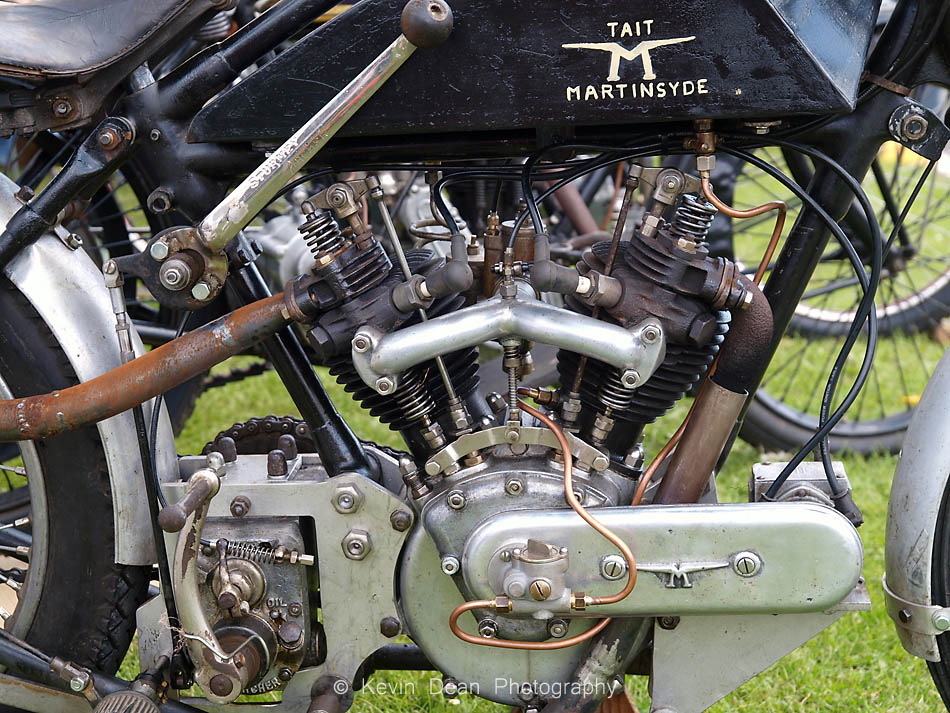
Martinsyde Motorcycles

Martinsyde was a British aircraft and motorcycle manufacturer between 1908 and 1922, when they were forced into liquidation by a factory fire.
|
Former type |
Private |
|---|---|
| Industry | Motorcycle, Aviation |
| Fate | Liquidated after a factory fire |
| Founded | 1908 |
| Founder | H.P. Martin and George Handasyde |
| Defunct | 1922 |
| Headquarters | Woking and Brooklands,England |
|
Key people |
H.P. Martin and George Handasyde |
| Products | Motorcycles, Aircraft |
History
The company was first formed in 1908 as a partnership between H.P. Martin and George Handasyde and known as Martin & Handasyde. Their No.1 monoplane was built in 1908–1909 and succeeded in lifting off the ground before being wrecked in a gale. They went on to build a succession of largely monoplane designs although it was a biplane, the S.1 of 1914, that turned Martin-Handasyde into a successful aircraft manufacturer.
In 1915 they renamed the company Martinsyde Ltd and became Britain's third largest aircraft manufacturer during World War One, with flight sheds at Brooklands and a large factory in nearby Woking.
Martinsyde Motorcycles
Martinsyde began manufacturing motorcycles from 1919 after buying the rights to engine designs by Howard Newman which included a 350 cc single and a 677 cc V-twin with an unusual exhaust-over-inlet layout.
The 680 engine was fitted into a diamond-type frame with Brampton forks. Martinsyde had to overcome problems with components before their new range could be launched, initially under the trade name of Martinsyde-Newman until the third partner Newman left the company. Newman was also involved in manufacturing and designing the Ivy (motorcycles). The motorcycle twin had a hand gear change and a three-speed gearbox built under licence from AJS. The Martinsyde’s engine was very flexible and became popular for off-road trials competition, where the singles quickly gained a reputation for reliability, at Brooklands, where Martinsyde won the team award in 1922, and the Scottish Six Days Trial.
Martinsyde motorcycles were offered with sidecars and the Martinsyde 680 was followed by a 500 cc model in 1920, with a sports version in 1921. In 1922 Martinsyde produced a 738 cc sports V-twin, named the Quick Six which produced 22 horsepower (16 kW) and was capable of 80 miles per hour (130 km/h). The engine featured their normal overhead exhaust and side-valve inlet, but Ricardo pistons, accurately balanced flywheels, all reciprocating parts lightened, nickel steel con-rods machined all over, and close ratio three speed gearbox. Martinsyde were experimenting with new designs, including valve gear controlled by leaf springs, when their Woking factory was destroyed by a fire in 1922, forcing them into liquidation having produced over 2,000 motorcycles. The company's motorcycle manufacturing rights were purchased by Bat Motor Manufacturing Co. Ltd, who produced a number of twin-cylinder motorcycles in 1924 and 1925 before ending production.
Martinsyde aircraft
Martinsyde-designed aircraft included:
- Martin-Handasyde No.3 - sports aircraft, 1910
- Martinsyde S.1 - single-seat scout, 1914
- G100 and G102 "Elephant" – scout aircraft 1915 onwards, 171
- Martinsyde RG
- Martinsyde F.1
- Martinsyde F.2
- Martinsyde F.3 – private venture design with the Rolls-Royce Falcon engine, only a few produced due to lack of available engines
- Martinsyde F.4 Buzzard – fighter, the F.3 with a Hispano-Suiza engine
- Martinsyde Semiquaver - racing aircraft
A number of surplus Buzzard airframe were later built up with a new engine, the radial Armstrong Siddeley Jaguar, by the Aircraft Disposal Company(ADC) and sold as the "Martinsyde ADC.1" in 1924. A development of the F.4 was also made by the ADC: two "ADC Nimbus" were produced as prototypes. The company also manufactured the BE.2c and S.E.5a aircraft under sub-contract.
No models found
